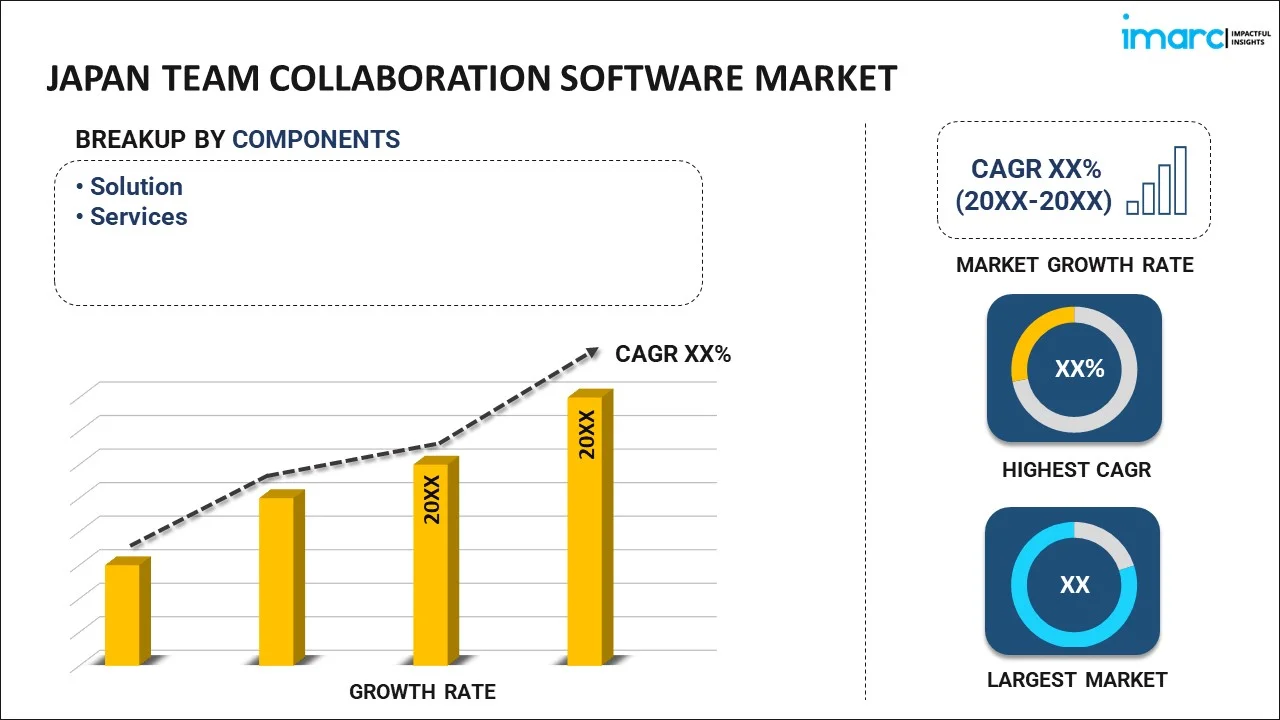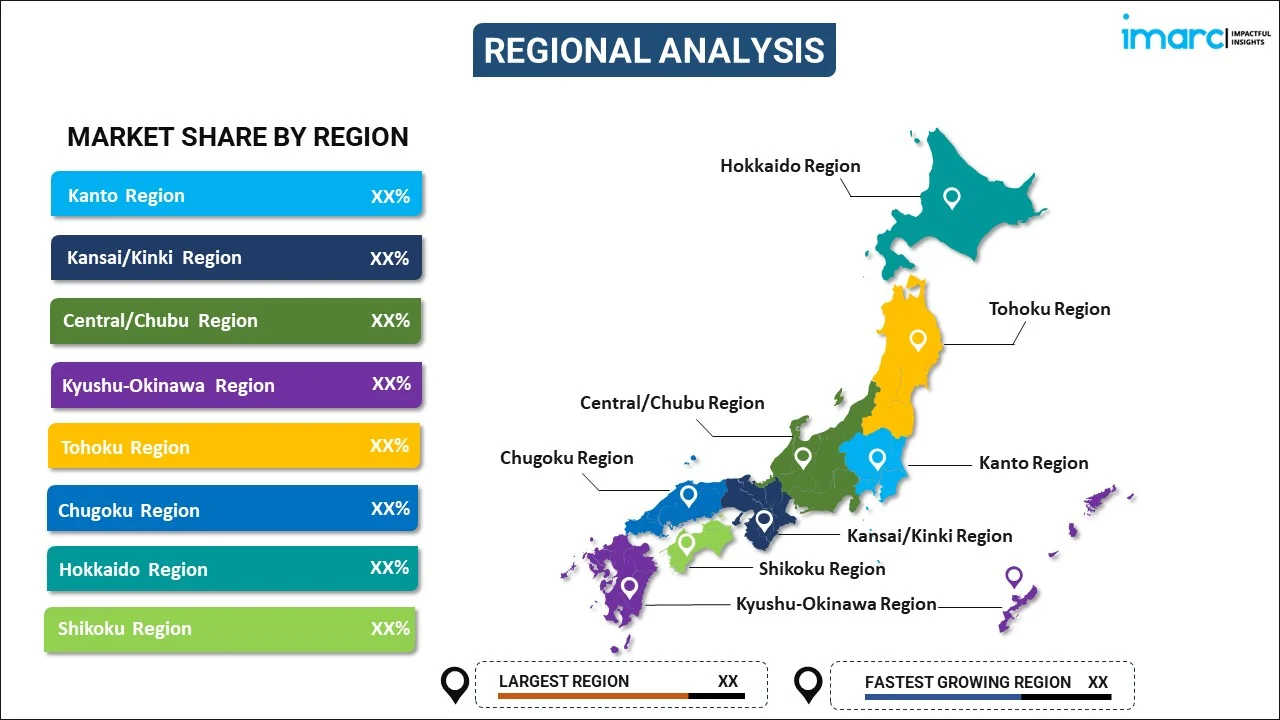
Japan Team Collaboration Software Market Report by Component (Solution, Services), Software Type (Conferencing, Communication and Co-Ordination), Deployment Mode (On-premises, Cloud-based), Industry Vertical (BFSI, Manufacturing, Healthcare, IT and Telecommunications, Retail and E-commerce, Government and Defense, Media and Entertainment, Education, and Others), and Region 2025-2033
Market Overview:
The Japan team collaboration software market size reached USD 1.1 Billion in 2024. Looking forward, IMARC Group expects the market to reach USD 3.5 Billion by 2033, exhibiting a growth rate (CAGR) of 12.73% during 2025-2033. The increasing shift toward remote work and hybrid work models, the rising adoption of collaboration tools for sensitive information, and the growing popularity of cloud-based solutions represent some of the key factors driving the market.
|
Report Attribute
|
Key Statistics
|
|---|---|
|
Base Year
|
2024
|
|
Forecast Years
|
2025-2033
|
|
Historical Years
|
2019-2024
|
|
Market Size in 2024
|
USD 1.1 Billion |
|
Market Forecast in 2033
|
USD 3.5 Billion |
| Market Growth Rate 2025-2033 | 12.73% |
Team collaboration software, often referred to as collaborative work management or team productivity software, is a type of application or platform designed to facilitate and enhance communication, coordination, and collaboration among team members within an organization. Its primary purpose is to streamline teamwork, improve productivity, and enable more efficient project management. It typically includes a range of communication tools, such as chat, instant messaging, and discussion boards. These features allow team members to communicate in real-time, share information, ask questions, and discuss ideas without the need for lengthy email exchanges or in-person meetings. They also enable easy sharing of documents, files, and resources within the team. Team members can upload, access, edit, and collaborate on documents in a centralized location. This feature helps prevent version control issues and ensures everyone is working with the most up-to-date information. Team collaboration software often includes task and project management tools. Team leaders can assign tasks, set deadlines, and track progress. This helps ensure that everyone knows their responsibilities and that projects are completed on time.
Japan Team Collaboration Software Market Trends:
The COVID-19 pandemic accelerated the shift toward remote work and hybrid work models in Japan. As organizations adapted to these new working arrangements, the demand for team collaboration software surged. Businesses needed tools that could facilitate communication, project management, and collaboration among remote and dispersed teams. In addition, many Japanese companies are actively pursuing digital transformation initiatives to stay competitive in the global market. Team collaboration software plays a crucial role in these efforts by enabling efficient communication and collaboration, driving productivity, and supporting innovation. Besides, Japanese businesses are placing a greater emphasis on improving productivity and efficiency in their operations. Team collaboration software helps streamline processes, reduce manual tasks, and enhance communication, ultimately leading to improved productivity levels. Moreover, integration capabilities have become a key driver for team collaboration software. Organizations in Japan seek solutions that can seamlessly integrate with other software tools they use, such as project management, CRM, and document management systems. This integration enhances workflow automation and data sharing. Additionally, cloud-based team collaboration software solutions are preferred for their scalability, accessibility, and reduced IT infrastructure costs. As a result, the adoption of cloud-based collaboration tools is on the rise in Japan, catering to businesses of all sizes. Furthermore, with the increasing use of collaboration tools for sensitive information, organizations in Japan are placing a strong emphasis on security and compliance features. Ensuring data protection and compliance with relevant regulations is a critical driver in the adoption of team collaboration software.
Japan Team Collaboration Software Market Segmentation:
IMARC Group provides an analysis of the key trends in each segment of the market, along with forecasts at the country level for 2025-2033. Our report has categorized the market based on component, software type, deployment mode, and industry vertical.
Component Insights:

- Solution
- Services
The report has provided a detailed breakup and analysis of the market based on the component. This includes solution and services.
Software Type Insights:
- Conferencing
- Communication and Co-Ordination
A detailed breakup and analysis of the market based on the software type have also been provided in the report. This includes conferencing and communication and co-ordination.
Deployment Mode Insights:
- On-premises
- Cloud-based
The report has provided a detailed breakup and analysis of the market based on deployment mode. This includes on-premises and cloud-based.
Industry Vertical Insights:
- BFSI
- Manufacturing
- Healthcare
- IT and Telecommunications
- Retail and E-commerce
- Government and Defense
- Media and Entertainment
- Education
- Others
A detailed breakup and analysis of the market based on the industry vertical have also been provided in the report. This includes BFSI, manufacturing, healthcare, IT and telecommunications, retail and e-commerce, government and defense, media and entertainment, education, and others.
Regional Insights:

- Kanto Region
- Kansai/Kinki Region
- Central/ Chubu Region
- Kyushu-Okinawa Region
- Tohoku Region
- Chugoku Region
- Hokkaido Region
- Shikoku Region
The report has also provided a comprehensive analysis of all the major regional markets, which include Kanto Region, Kansai/Kinki Region, Central/ Chubu Region, Kyushu-Okinawa Region, Tohoku Region, Chugoku Region, Hokkaido Region, and Shikoku Region.
Competitive Landscape:
The market research report has also provided a comprehensive analysis of the competitive landscape. Competitive analysis such as market structure, key player positioning, top winning strategies, competitive dashboard, and company evaluation quadrant has been covered in the report. Also, detailed profiles of all major companies have been provided.
Japan Team Collaboration Software Market Report Coverage:
| Report Features | Details |
|---|---|
| Base Year of the Analysis | 2024 |
| Historical Period | 2019-2024 |
| Forecast Period | 2025-2033 |
| Units | Billion USD |
| Scope of the Report | Exploration of Historical Trends and Market Outlook, Industry Catalysts and Challenges, Segment-Wise Historical and Future Market Assessment:
|
| Components Covered | Solution, Services |
| Software Types Covered | Conferencing, Communication and Co-Ordination |
| Deployment Modes Covered | On-premises, Cloud-based |
| Industry Verticals Covered | BFSI, Manufacturing, Healthcare, IT and Telecommunications, Retail and E-commerce, Government and Defense, Media and Entertainment, Education, Others |
| Regions Covered | Kanto Region, Kansai/Kinki Region, Central/ Chubu Region, Kyushu-Okinawa Region, Tohoku Region, Chugoku Region, Hokkaido Region, Shikoku Region |
| Customization Scope | 10% Free Customization |
| Post-Sale Analyst Support | 10-12 Weeks |
| Delivery Format | PDF and Excel through Email (We can also provide the editable version of the report in PPT/Word format on special request) |
Key Questions Answered in This Report:
- How has the Japan team collaboration software market performed so far and how will it perform in the coming years?
- What has been the impact of COVID-19 on the Japan team collaboration software market?
- What is the breakup of the Japan team collaboration software market on the basis of component?
- What is the breakup of the Japan team collaboration software market on the basis of software type?
- What is the breakup of the Japan team collaboration software market on the basis of deployment mode?
- What is the breakup of the Japan team collaboration software market on the basis of industry vertical?
- What are the various stages in the value chain of the Japan team collaboration software market?
- What are the key driving factors and challenges in the Japan team collaboration software?
- What is the structure of the Japan team collaboration software market and who are the key players?
- What is the degree of competition in the Japan team collaboration software market?
Key Benefits for Stakeholders:
- IMARC’s industry report offers a comprehensive quantitative analysis of various market segments, historical and current market trends, market forecasts, and dynamics of the Japan team collaboration software market from 2019-2033
- The research report provides the latest information on the market drivers, challenges, and opportunities in the Japan team collaboration software market.
- Porter's five forces analysis assist stakeholders in assessing the impact of new entrants, competitive rivalry, supplier power, buyer power, and the threat of substitution. It helps stakeholders to analyze the level of competition within the Japan team collaboration software industry and its attractiveness.
- Competitive landscape allows stakeholders to understand their competitive environment and provides an insight into the current positions of key players in the market.
Need more help?
- Speak to our experienced analysts for insights on the current market scenarios.
- Include additional segments and countries to customize the report as per your requirement.
- Gain an unparalleled competitive advantage in your domain by understanding how to utilize the report and positively impacting your operations and revenue.
- For further assistance, please connect with our analysts.
 Inquire Before Buying
Inquire Before Buying
 Speak to an Analyst
Speak to an Analyst
 Request Brochure
Request Brochure
 Request Customization
Request Customization




.webp)




.webp)












